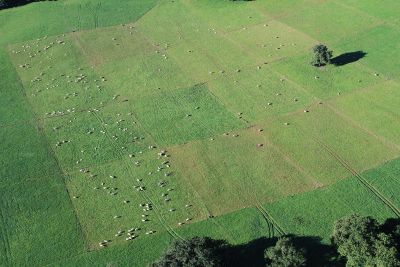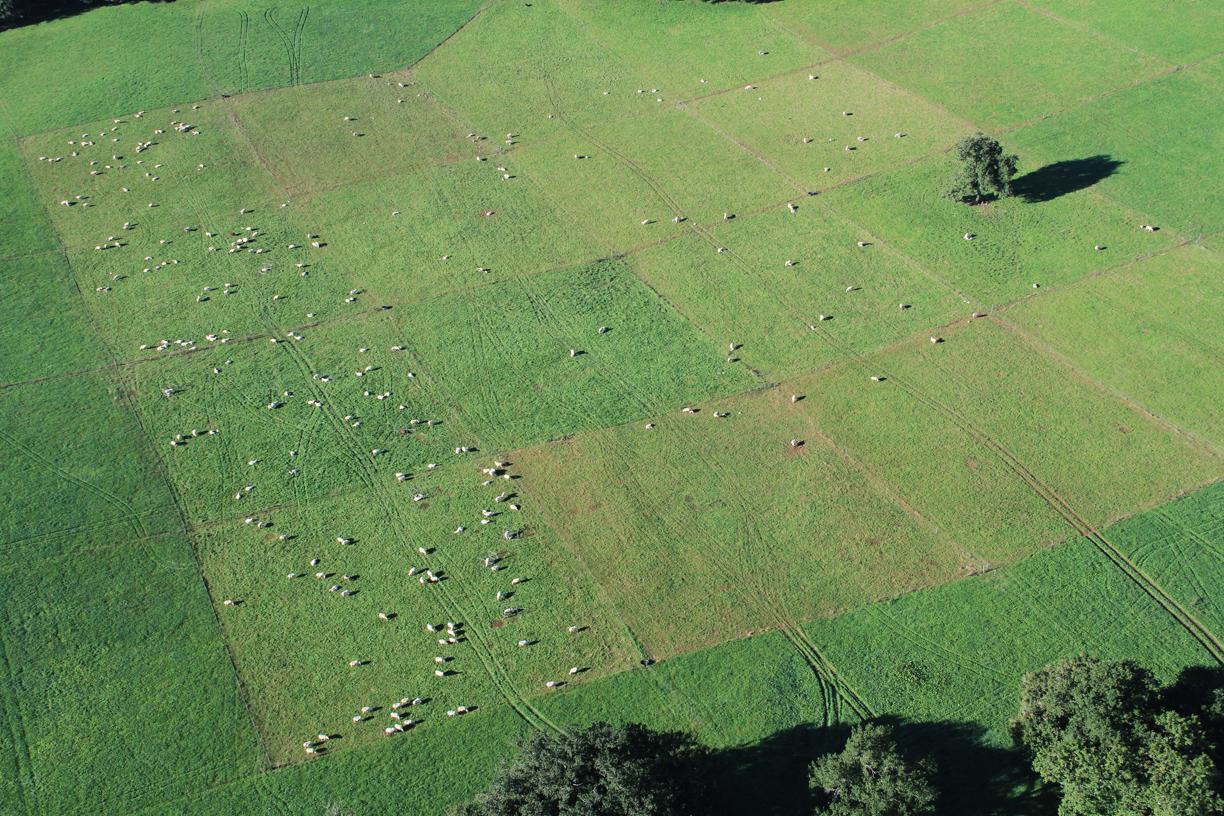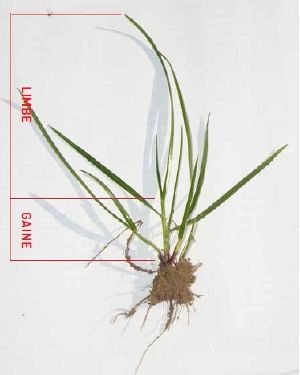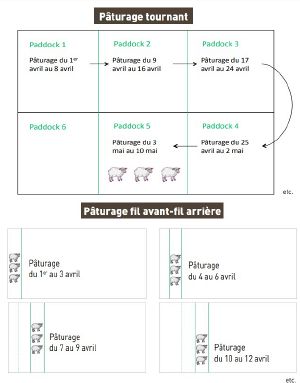Rotational grazing
 Producing grass while maximising productivity
Producing grass while maximising productivity

Sincegrazed grass is still the cheapest feed available, it is important to make the most of this forage resource in a context of tight and fluctuating cash flow. Although the practice of rotational grazing is a long-established one, it is still very much in use today, and represents a major lever in the quest forself-sufficiency and reduced costs.
A tried and tested technique with a host of benefits !
Better grass management :
- In spring : no overflow, paddocks can be mown.
- In summer : better management of dry spells.
Increased grass area :
- Fewer refusals.
- Denser plot.
Improved animal performance :
- Quality grass used at the right stage.
Lower fertilisation :
- Even distribution of manure.
- Increases the legume content of grassland(white clover).
Grass grazed in the spring produces 25 kg of milk per day.
Although this grazing technique is making a comeback in the current global context, it is no less ancient. The first experiments with rotational grazing date back to ... 1957 !
Since then, the technique has been tested and evaluated on numerous experimental farms and in the field by farmers. The results are all the same : if the organisation of the plots, the access roads and the water points are well thought out, grazing results in the ruminants getting more out of the grass, which also means less need to buy concentrates, less area used for maize and less working time.
The following information, largely inspired by André Voisin's observations and reflections, offers a few guidelines for farmers wishing to make the most of the potential of their meadows and promote the good health and production of their animals as part of a farming approach that is as " natural " as possible.
Grazing is " the meeting of the cow and the grass " and the requirements of both the cow and the grass must be taken into account.
The basic laws of rational grazing (André Voisin method)
In order to achieve quality rotational grazing, it is possible to monitor four basic principles, although these principles are not rigid rules to be followed whatever the context.
First law
For grazed grass to be at its most productive, sufficient time must have elapsed between two successive shearings by the animal's tines to allow the grass :
- Accumulate in its roots the reserves necessary for good regrowth.
- Achieve its most rapid growth (growth flare-up).
This resting time varies according to place, season and year, but an average can be determined for each situation.
Second law
The overall occupation time of a plot must be short enough to ensure that grass cut at the beginning of the occupation time is not grazed again before the animals leave the plot.
Third law
The animals with the highest feed requirements must be helped to harvest a high quantity of grass of the best possible quality.
Fourth law
For a cow to perform consistently, observation shows thatshe should notstay on the same plot for more than three days.
Maximum performance will be achieved if the animal stays on the same plot for no more than one day.
Understanding grass growth for better management
How does grass work ?

The leaf = the sheath + the blade.
The length of the blade is proportional to that of the sheath, with the ratio :
Blade length = 2.3 x sheath length.
At 14 cm = the blades will be long but so will the sheaths, which will lead to refusals !
Attention ! Grass reserves are located at the tillering plateau and at the base of the stems. If the animals graze too low, they will deplete the reserves and penalise the plant's regrowth and even its survival !
Here are a few guidelines to avoid overgrazing :
- Do not grazebelow 5 cm.
- Graze less than 50 % of the leaf area.
- Stay less than 3 days per paddock :
- D1 -> the plant is grazed.
- D4 -> the plant restarts a new cycle by mobilising its reserves.
The feed value (nitrogen and energy) required by animals is contained mainly in the leaf blade.
How often should the grass be grazed ?
The best time to graze is very difficult to determine; it's a question of " glance " ; in general, we can say that the best time to graze is between 8 and 14 centimetres high.
In fact, in practice, this height will often be higher at the beginning of the season and lower at the end :
What's more, grazing dates don't just depend on the height of the grass ; they also depend on weather conditions: if the weather is dry and the grass vegetates, the cows have to eat anyway.
For quality grazing, we try to leave the plant enough time to rest so that it can replenish its reserves and start again in good conditions.
Given the composition of French grasslands, we now know that, on average, by the 3-leaf stage, the reserves of the tillers have been replenished, after which their feed value decreases.
The 3-leaf stage is a good time to graze a grass in order to maintain good animal performance without damaging the potential of the meadow.
Planning and organising grazing
Dividing the meadow into several paddocks
When you draw up a grazing plan, you first need to decide on the number of paddocks. You then deduce their surface area. It is the number of paddocks, and not their surface area, that determines the resting times of the paddocks.
Ideally, the time needed for the grass toreach a height of 8 to 14 cm should be used to determine the resting time of the paddock.
This resting time is not fixed throughout the year; it varies according to the season, the soil and climate conditions and the year.
For example :
- 18 to 21 days in spring.
- 35 days in summer.
- 40 days in autumn.
It's a good idea for the most productive animals to be placed in conditions that allow them to harvest more grass ; dividing the herd into groups helps to achieve this objective: the most productive or lactating cows go first to " skim " the grass, with the others following behind.
It should be noted that this division of the herd into groups does little to reduce rest periods.
If, for example, we have a system with twenty paddocks and a herd staying two days on each paddock, the resting time for each paddock is 20 days in total minus one occupied paddock, i.e. 19, multiplied by the stay time, which in this case is two days ; this gives a resting time of 38 days for each paddock.
Number of plots at rest x residence time = rest time
With 2 groups, the resting time becomes : (20 - 2) x 2 = 36 days.
And with 3 groups : (20 - 3) x 2 = 34 days.
So we can see that the resting time of the grass is only slightly affected by the number of groups grazing.
What is the best resting time and the optimum number of groups ?
This obviously varies according to local conditions, the composition and size of the herd, etc. However, as an average solution, we can give 2 days' grazing with a herd divided into 2 groups, but it goes without saying that this is an average solution and it is up to each farmer to adapt the basic principles to his own particular case, always bearing in mind the need to respect the grass's resting time.
The plot must also be grazed properly, neither too much nor too little, and this factor can also lead to a variation in the dwell time.
Number of plots required depending on the number of groups :
| Residence time for a group | 1 group | 2 groups | 3 groups |
|---|---|---|---|
| 1 day | 37 plots | 38 plots | 39 plots |
| 2 days | 19 plots | 20 plots | 21 plots |
| 3 days old | 13 plots | 14 plots | 15 plots |
| 4 days | 10 plots | 11 plots | 12 plots |
Fencing
It is a good idea for each large paddock to be divided up to be surrounded by a fixed wire fence or hedge ; the fences used to delimit the rationing paddocks are lighter so that they can be moved around at the beginning, during the trial period and even afterwards, if the need arises.
Electric fencing is obviously a practical mobile fence, although not always very safe.
The water problem
Arrangements need to be made to ensure that the group(s) can drink at all times.
Various systems are possible, and here are three simple theoretical examples that can be modified and adapted.
Remarks : In figure B, the cows are in plot 2 and the opening of the gate in this plot, which allows the animals to move towards the waterhole, also prevents them from moving backwards in the access corridor, thus preventing it from being trampled too much. In the case of figure C, the most convenient watering point is a combination of : well/large tank/pump powered by a wind turbine in regions where there is sufficient wind.
Putting out to grass
Grazing must always be gradual to avoid accidents, but in the case of rational grazing, it must be carried out with particular care ; in fact, if you wait until the grass on the first plots has grown sufficiently before putting the animals out to pasture, the last plots in the first rotation run the risk of having grass that is hardened and too long.
On the other hand, if you graze them too early, you run the risk of delaying grass regrowth. So you need to find a happy medium and graze the first plots a little before the grass has reached its optimum length.
The problem can also be partially solved by applying fermented liquid manure in aerobic conditions at the start of the year, or at least with a lot of water, in varying doses depending on the plot.
The largest doses are applied to the plots that are grazed first. The last plots only receive a small amount.
In this way, the grass grows back progressively and, by the second rotation, the first plots, which are heavily supported by the slurry, will have grown back well. This assumes, of course, that slurry is available at the right time.
De-sludging part of the plots is also a solution for delaying their start-up and, in some cases, for limiting soil contamination. It is important to ensure that this is done under the right conditions.
The date on which grass is cut has an influence on the flora of the grassland, because depending on whether a plant is cut at a more or less sensitive period in its vegetation, it will grow back more or less well, be dominated by the other grasses or, on the contrary, smother them.
It is therefore important to put grass down each year on different plots so that differences in flora between the plots do not gradually become apparent over the years.
Managing grass variation between seasons
If the grass grows faster than expected, don 't hesitate to extend the dwell time a little. If the grass is not growing as quickly as expected, you can shorten it and use another reserved plot or a food source from outside the grassland.
A number of methods can be used to maintain a constant supply of nutrients to the herd despite seasonal variations in the grass available for grazing.
Varying the number of paddocks grazed
This technique involves mowing certain plots in the spring to obtain hay and then grazing them as and when required : this is regrowth grazing.
Example : We want a rest period of 42 days at the end of summer and 18 days in spring.
This change can only be achieved by varying the number of paddocks grazed.
If the occupation time is 2 days, then :
- in September at rest 42 : 2 = 21 paddocks with, in addition, the occupied paddock, making 22 paddocks ;
- in spring, only 18 : 2 + 1 = 9 + 1 = 10 plots.
In the spring, therefore, there will be 12 plots that will be mown and introduced into the rotation as and when required during the summer.
The number of plots mown will also depend on the farm's hay requirements.
As a general rule, the number of plots " " should not be too low, to avoid being at the mercy of an unexpected drought, for example.
Grazing temporary grassland or cover crops
On mixed crop-livestock farms practisingorganic farming, it is generally necessary to introduce legume-based temporary grassland into the rotation.
These temporary grasslands can be used to compensate for fluctuations in grass growth, either in the form of green fodder in cowsheds or stables, or in the form of pasture.
Introduction of green fodder
Spring and winter cabbage, rape, broad bean, turnip, etc. and green manures can be used as fodder.
It's up to each farmer to make the best use of them, depending on the conditions on his farm.
Feeding with dry feed
Refeeding with dry feed (hay, cereals) should normally be reserved for winter feeding, but in years with extremely poor weather conditions it may be necessary to do so during the grazing season.
In organic cattle farming, this should remain a practice linked to climatic conditions and not become a form of intensification that is always risky in terms of animal health and dairy product quality.
Different types of rotational grazing

Rotational grazing, dynamic grazing and forward/backward grazing are all different practices used to achieve the same goal : to regularly offer the animals a new area to graze quality grass, made up of young shoots, guaranteeing a balanced, rich feed.
| Stage | Energy value | Nitrogen value |
|---|---|---|
| Leafy | 0.97 UFL/kg DM | 17% MAT |
| Early heading | 0.89 UFL/kg DM | 13% MAT |
| Flowering | 0.66 UFL/kg DM | 9% MAT |
Dynamic rotational grazing
Several pastures are grazed in turn to give the plot time to recover.[2].
Adaptation
- Milk : Minimum of 6 paddocks in the spring with 3-4 days' attendance. Access to the paddocks must be easy.
- Meat : Minimum of 4 paddocks in the spring with an attendance time of 5-6 days.
| Advantages | Disadvantages |
|---|---|
|
|
Rationed rotational grazing[2]
Rotational grazing + front wire.
Adaptation
- Milk : Used to provide the animals with a menu of new grass every day or every meal.
- Meat : Little used
| Advantages | Disadvantages |
|---|---|
|
|
Rationed grazing, front wire, back wire
Delimit the pasture on a plot with one or two wires that the farmer has to move every day.[2].
Adaptation
- Milk : More rarely used because of the time constraints.
- Meat : Not or very little used.
| Advantages | Disadvantages |
|---|---|
|
|
Cellular grazing
Principle of front wire/rear wire grazing, with pre-established cells (very high instantaneous loading and with a very short dwell time).[2].
Adaptation
- Milk : Still not very developed, but possible.
- Meat : Still not very developed, but possible.
| Advantages | Disadvantages |
|---|---|
|
|
Further information
- Guide to grazing - Herbe et fourrages Centre
- Dynamic rotational grazing (2020)
- Listen to the Normandy Chambers of Agriculture podcast on the subject by clicking here.
Sources
- Chambre d'agriculture de Lorraine.2018.Rotational grazing : what you need to know
- Olivier Leray et al.2017.Presentation of the different grazing techniques according to the herbivore species used.
- Joseph Pousset - Association Nature et Progrès,AGRECO, GRAB.2009.Le pâturage " tournant " : importance, conception et conduite.